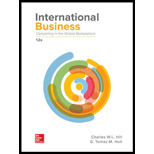
a)
To discuss: The current economic history of Country B point out about the relationship between exchange and price inflation rates.
Introduction:
A value of one country’s currency is used to convert into another country’s currency is termed as an exchange rate. The rate of exchange can be either floating or fixed. The two components of the exchange rates are the foreign currency and the domestic currency.
A rise in the value of the goods and services in an economy for a period of time is termed as inflation.
To discuss: The other factors which define the exchange rate of Country B’s currency.
b)
To discuss: Whether the decline in the value of Country B’s currency against the Country U’s dollar is good, bad, or a mixed bag for E Company.
c)
To discuss: The type of foreign exchange rate risks of E Company.
Introduction:
Risk refers to the movement in the value of an investment. The movement can be positive or negative. The investor will gain if the movement is positive, and the investor will lose if the movement is negative.
To discuss: Whether the E Company can reduce this risk and its approach to reduce risks.
d)
To discuss: Whether the E Company’s decision to attempt and hedge against further appreciation of Country B’s currency in the early 2000s is a good decision and its alternatives.
e)
To discuss: Whether the E Company’s operation is a wise decision.
f)
To discuss: The impact on E Company due to the
Trending nowThis is a popular solution!

Chapter 10 Solutions
International Business: Competing in the Global Marketplace
- Please help me solve this general accounting question using the right accounting principles.arrow_forwardOlympic Corporation purchased equipment for $480,000 on July 1, 2012. The estimated service life is eight years with a $48,000 residual value. Olympic records partial-year depreciation based on the number of months in service. Depreciation expense for the year ended December 31, 2012, using straight-line depreciation, is? Helparrow_forwardCan you explain the process for solving this financial accounting question accurately?arrow_forward
- Fiona Industries plans to produce 30,000 units next period at a denominator activity of 60,000 direct labor hours. The direct labor wage rate is $16.50 per hour. The company's standards allow 2.2 yards of direct materials for each unit of product; the material costs $10.50 per yard. The company's budget includes a variable manufacturing overhead cost of $3.25 per direct labor hour and fixed manufacturing overhead of $285,000 per period. Using 60,000 direct labor hours as the denominator activity, compute the predetermined overhead rate and break it down into variable and fixed elements.arrow_forwardCan you help me solve this general accounting problem using the correct accounting process?arrow_forwardI need help with this problem and accountingarrow_forward
- Mao Manufacturing has a net working capital of $15,600, current assets of $42,800, equity of $73,200, and long-term debt of $18,400. What is the amount of net fixed assets?arrow_forwardPlease provide the accurate answer to this financial accounting problem using appropriate methods.arrow_forwardI need assistance with this general accounting question using appropriate principles.arrow_forward
- I am trying to find the accurate solution to this general accounting problem with the correct explanation.arrow_forwardQuick answer of this general accounting questionarrow_forward10. A retirement account earns an annual interest rate of 5%. If you contribute $4,000 per year for 6 years, what will be the total value of the account after 6 years? give me solution..,??arrow_forward
 Foundations of Business (MindTap Course List)MarketingISBN:9781337386920Author:William M. Pride, Robert J. Hughes, Jack R. KapoorPublisher:Cengage Learning
Foundations of Business (MindTap Course List)MarketingISBN:9781337386920Author:William M. Pride, Robert J. Hughes, Jack R. KapoorPublisher:Cengage Learning Foundations of Business - Standalone book (MindTa...MarketingISBN:9781285193946Author:William M. Pride, Robert J. Hughes, Jack R. KapoorPublisher:Cengage LearningMarketingMarketingISBN:9780357033791Author:Pride, William MPublisher:South Western Educational Publishing
Foundations of Business - Standalone book (MindTa...MarketingISBN:9781285193946Author:William M. Pride, Robert J. Hughes, Jack R. KapoorPublisher:Cengage LearningMarketingMarketingISBN:9780357033791Author:Pride, William MPublisher:South Western Educational Publishing




